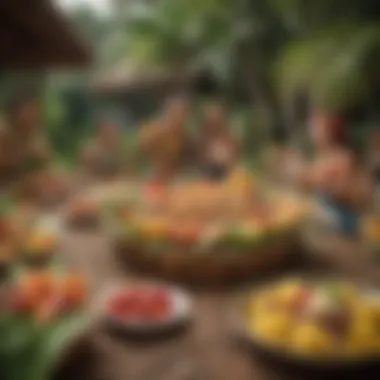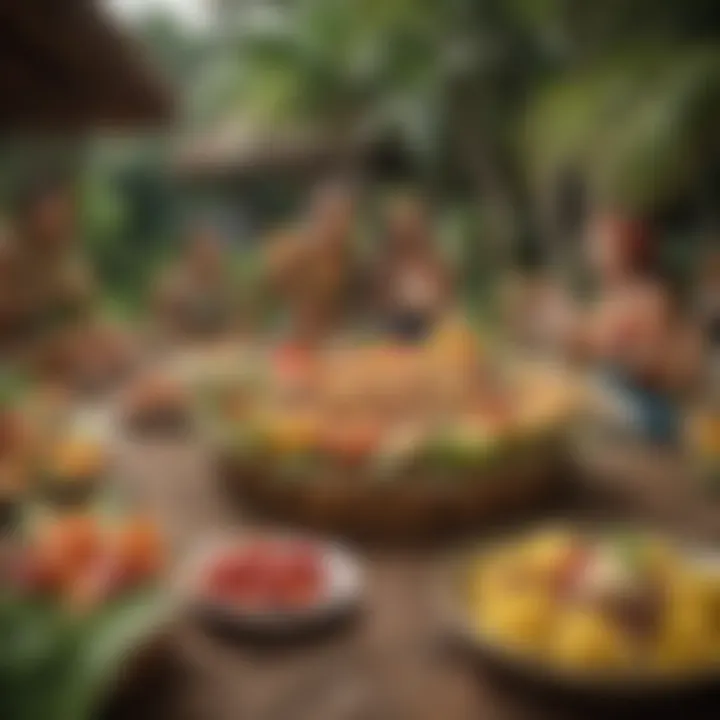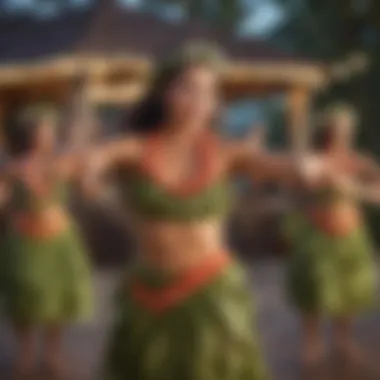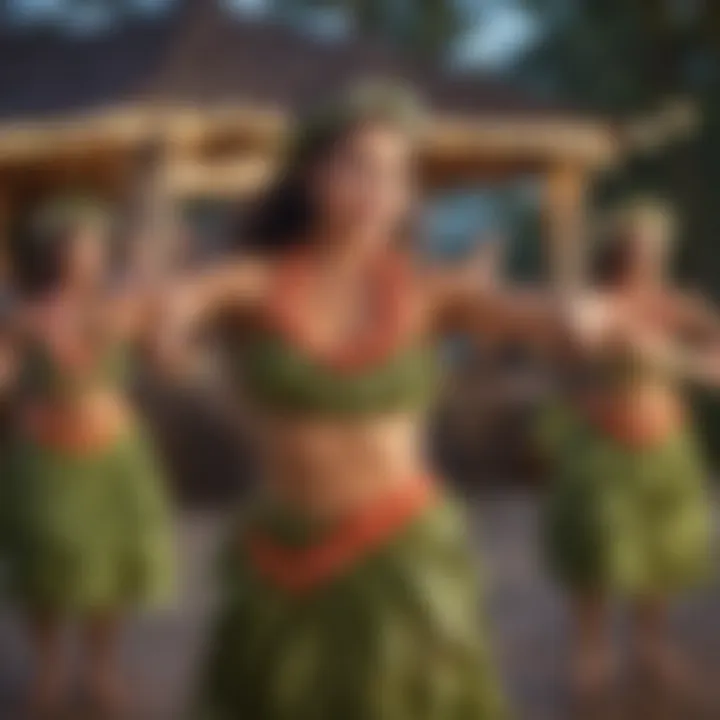Discovering the Heart of a Hawaiian Luau Party


Intro
A Hawaiian luau is more than just a party; it is a vibrant tapestry of culture, history, and culinary experience that captures the spirit of the islands. This celebration embodies joy, community, and tradition, making it a cherished event for locals and visitors alike. The roots of the luau can be traced back centuries, emerging from ancient traditions where gatherings were a way to honor gods and celebrate life’s milestones. Today, the luau has evolved, integrating elements of dance, music, and gastronomy that tell the story of Hawaii’s rich heritage.
Imagine stepping into a world filled with the tantalizing scent of kalua pig cooking in an underground oven, the rhythmic pulse of Hawaiian music enveloping your senses, and vibrant hula dancers gracefully moving to the beat. Whether you’re hosting a luau for a special occasion or participating in one as a guest, understanding the fundamental mechanisms that hold a luau together is essential.
In the sections that follow, we will dissect the essence of the Hawaiian luau, from customary practices to modern adaptations. You will learn about the key ingredients that create an unforgettable experience, the intricate details surrounding the preparations, and the cultural significance behind the dishes served and the dances performed.
As we sail through this exploration, you will gain insights into how to create a festive atmosphere right in your backyard, echoing the spirit of the islands. Get ready to embrace tradition while savoring the culinary delights that a luau promises.
Understanding the Luau Tradition
The luau is more than just a party; it embodies the heart and soul of Hawaiian culture. Understanding the traditions that underpin these lively gatherings is invaluable, as it not only enhances the experience but also fosters greater appreciation for this unique celebration. A luau can be a feast for the senses, offering a rich tapestry of flavors, sounds, and sights that are unmistakably Hawaiian. The importance of understanding this tradition cannot be overstated for both hosts and guests alike. It’s about participating in a cultural narrative that has been woven through generations.
Historical Origins of the Luau
Historically, luaus originated from ancient Hawaiian feasts. In the old days, these gatherings were a time to honor a significant achievement or event, often presided over by ali'i, or chiefs. Back then, the luaus were exclusive to men and had strict rules regarding food and rituals. Women were not allowed to partake in the meal, a sign of the societal structure of the time.
As time passed and societal norms evolved, luaus expanded to include everyone, becoming more celebratory in nature. These gatherings now feature a range of traditional dishes, or "ono" food, brought to the table by all attendees, filling the air with aromas that are a part of the island identity. An integral dish, Kalua pork, exemplifies this; slow-cooked in an underground oven known as a imu, this dish represents the resourcefulness and artistry of ancient Hawaiian cooking methods.
The spirit of sharing, which is so central to these celebrations, continues to resonate. Luaus have become events to share cultural tales and hospitality, opening a window into a way of life that values community connection.
Cultural Significance in Hawaiian Society
In Hawaiian society, the luau is a powerful medium for expressing cultural identity and heritage. It serves as a manifestation of Aloha, a term that transcends mere greetings to embody love, peace, and compassion. Gathering for a luau allows participants to engage with their roots, portraying a deep-seated respect for tradition.
"The luau is not just a meal or entertainment; it's a tapestry of culture, history, and shared experiences."
Moreover, luaus are often intertwined with significant life events—birthdays, graduations, and weddings. It’s common to see elaborate performances of hula or chanting, showcasing the vibrant storytelling traditions of Hawaii. This live entertainment offers insight into the islands' rich history, transforming each gathering into an educational experience.
Through understanding the luau tradition, one realizes that these gatherings are more than festive occasions; they hold the weight of ancestral knowledge and community expressiveness. Embracing these elements not only enriches individual experiences but ultimately contributes to preserving and promoting Hawaiian cultural values.
Essential Elements of a Luau Party
The heart of a memorable luau lies in its essential elements, which come together to create an unforgettable experience. Each aspect—from decorations to attire—serves not only to beautify the event but also to deepen the meaning of the celebration. It's like stitching together a vibrant quilt, where every patch represents a part of the rich Hawaiian culture.
In this section, we explore the threads that hold a luau together, ensuring that this festive gathering reflects authenticity while enchanting guests.
Traditional Decorations and Ambiance
When it comes to setting the scene for a luau, decorations play an undeniably pivotal role. Picture a beach backdrop where swaying palm trees are draped with colorful leis and tiki torches dance with flames in the gentle breeze. The use of natural elements is key. Fresh flowers, vibrant fabrics, and traditional Hawaiian crafts envelop the space, creating an atmosphere that’s both inviting and breathtaking.
One might adorn tables with tropical centerpieces featuring hibiscus flowers or arrange fruit displays that make the food seem almost like an artwork. The aroma of grilled meats, kerfuffle of laughter, and the soft strum of ukuleles lingering in the air create a harmony that pulls everyone into the experience.
Here are some essential items to consider:
- Tiki Torches: Illuminate the night while giving that quintessential island vibe.
- Leis: Handing out these flower necklaces to guests is a gesture of welcome and love.
- Bamboo and Natural Materials: Use these for table settings or to create a rustic feel.
In summary, the ambiance awakens the senses and transports participants, making decor an indispensable part of the luau experience.
Attire and Dress Code for Guests
Attire at a luau isn’t just about looking good; it embodies the spirit of the islands. Encouraging guests to wear tropical-themed clothing helps to create that gorgeous visual splendor akin to an art exhibition. Imagine patterns that showcase lush greenery, vibrant flowers, and even hints of ocean hues.


Traditionally, aloha shirts for men and floral dresses for women offer comfort while celebrating culture. It’s also a nod to the laid-back island lifestyle, where every day can be an occasion. As such, choosing clothing that mirrors this ethos enhances the overall experience.
To facilitate thinking in your dress code, consider:
- Comfort over Formality: Guests will likely enjoy themselves more dressed casually.
- Bright Colors: Encourage lively prints that resonate with Hawaiian themes.
- Footwear: Given the outdoor setting, suggest flip-flops or even going barefoot for a more authentic feel.
Ultimately, the attire not only makes the event photogenic, but it invites guests to embrace the spirit of Aloha. It's a reminder that when dressing for a luau, you are stepping into a rich tapestry of culture and joy.
Culinary Aspects of a Luau
The culinary elements of a Hawaiian luau serve as the heart and soul of the event, transforming a gathering into a memorable feast steeped in tradition. Food at a luau is not simply for sustenance; it symbolizes the spirit of aloha, showcasing the abundance of the islands and the artistry of Hawaiian cuisine. Through the dishes served, guests experience the flavors of Hawaii, while also gaining insight into its rich cultural history.
The variety offered at a luau encapsulates the vibrancy of Hawaiian culture and offers a sensory celebration that engages not just the palate but the heart as well, making it essential in understanding the essence of a luau party.
Signature Dishes to Consider
Kalua Pork
One of the cornerstone dishes of any luau is Kalua Pork, which is traditionally prepared in an underground oven, known as an imu. This method of cooking imbues the pork with a unique flavor, with the smoke from the banana leaves adding an irresistible aroma. Kalua pork has a juicy, tender texture that practically melts in your mouth. It exemplifies the communal aspect of a luau and is often served as the centerpiece of the feast.
The labor-intensive cooking process enhances its appeal, transforming what could be a simple dish into a connoisseur experience for guests. Because of its strong cultural roots and the flavors it brings, it’s considered a must-have at any luau.
Poke Salad
Another beloved dish is Poke Salad, which captures the freshness of the sea. This dish typically features cubed raw fish—such as ahi tuna—seasoned with soy sauce, sesame oil, and a variety of toppings such as onions and seaweed. The primary characteristic of poke is its bright, clean taste, which offers a refreshing contrast to the rich flavors found in other luau dishes. As a nod to the islands’ fishing heritage, poke salad stands out as an embodiment of sustainable food practices.
While being remarkably easy to make, it encourages a kind of culinary creativity at its core, allowing hosts to personalize the dish according to local catches or guest preferences. This versatility makes poke a popular choice for both locals and tourists alike.
Lomi Lomi Salmon
Lomi Lomi Salmon is another dish that deserves its place in the spotlight. Not only is it delightful in flavor, bursting with tomatoes, onions, and salted salmon, but it also has a rich history in Hawaiian culture. The preparation involves massaging the ingredients together—a practice that symbolizes the coming together of family and friends.
Opting for Lomi Lomi as part of a luau menu offers a vibrancy to the table, as its vivid colors and fresh taste delight both the eyes and the palate. Moreover, being a cold dish enhances its appeal on a warm evening, making it a refreshing option.
Traditional Cooking Methods
The traditional cooking methods used in luaus significantly elevate the dining experience. Each technique tells a story and connects before to the past of the Hawaiian people. The use of an imu for cooking meats and other dishes preserves moisture and flavor, translating to a depth of taste that modern cooking methods may not achieve. Furthermore, the community aspect of gathering around the imu and sharing in the preparation fosters a sense of unity among participants.
Role of Tropical Fruits and Beverages
No luau is complete without an array of tropical fruits that complement the main dishes. Fruits such as pineapple, mango, and coconut not only add sweetness but also enhance the visual appeal of the culinary spread. They are often used in salads or served as fresh sides, emphasizing the natural bounty of the islands.
Beverages play an equally crucial role, with options ranging from traditional pono drinks to fruity cocktails like piña coladas. These libations allow guests to savor the full spectrum of Hawaiian flavors, further enriching their experience. The careful selection of both fruits and drinks helps to create ambiance and authenticity in the luau setting, reinforcing the cultural significance embedded within these gatherings.
In essence, the culinary aspects of a luau transform the event into a rich tapestry of flavors and traditions. From the succulent Kalua pork to the vibrant poke and Lomi Lomi salmon, each dish serves as a testament to Hawaii's unique cultural heritage.
Entertainment at Luau Parties
The entertainment aspect of luaus is not just an add-on; it's the heartbeat of the entire celebration. Engaging in lively performances and cultural displays creates an atmosphere that transports guests to another time and place, showcasing Hawaii’s vibrant heritage. A well-planned luau embraces four pillars of entertainment: traditional hula dancing, live music, storytelling, and interactive experiences.
Traditional Hula Dancing
Hula dancing stands as one of the most visually emblematic components of any luau. It’s often said that hula is not simply a dance; it’s a language in movement, conveying stories and emotions through gestures and expressions. Each hula performance can reflect a piece of Hawaiian mythology or convey heartfelt messages about nature, love, or community. When guests witness a hula dancer performing, they don’t just see choreography but rather the essence of Hawaiian culture being shared.
Furthermore, hula encourages participation from the audience, often inviting them to join in. This communal aspect enriches the experience, creating a sense of unity and togetherness among attendees.


Live Music and Performance
A luau without music is like a fish out of water. Live music brings energy and enthusiasm to the gathering. Musicians typically play traditional Hawaiian songs using native instruments, blending rhythm and melody in a way that complements the festivities. The backdrop of guitars, ukuleles, and drums sets a vibrant tone and invites guests to relax and enjoy the moment.
Native Hawaiian Instruments
Native Hawaiian instruments are a crucial part of a genuine luau experience. The most notable instrument, the ukulele, is beloved for its sweet sound and portability. It's often said that the ukulele in the hands of a skilled player can evoke deep emotions and transport listeners to a tranquil beach under sunset skies.
Key characteristics of native Hawaiian instruments include:
- Authenticity: These instruments produce sounds intrinsic to Hawaiian culture, giving the music an unmistakable richness.
- Traditional craftsmanship: Many instruments are handcrafted, lending them unique qualities.
- Cultural legacy: Using these instruments in performances preserves a rich facet of Hawaiian identity.
The inherent advantage of featuring native instruments at luaus is their ability to evoke nostalgia and connect attendees with the land and its history. However, one must also navigate the balance of maintaining traditions while catering to contemporary tastes in music.
Contemporary Influences
As the world changes, so does the music performed at luaus. Contemporary influences have seeped into the traditional fabric, infusing more modern rhythms and styles. Incorporating elements from pop, reggae, and world music broadens the appeal of the performances, attracting a diverse audience.
Key characteristics of contemporary influences include:
- Diverse sounds: A blend of genres can make the event feel more inclusive and relatable to various cultural backgrounds.
- Innovation in performance: Artists might use hybrid instruments or new technologies to enhance the experience.
- Broadened appeal: By merging traditional and contemporary styles, luaus can reach a wider audience, thus promoting cultural exchange.
Nevertheless, the challenge lies in preserving the core themes and messages of Hawaiian culture while appealing to modern sensibilities. Striking this balance can lead to creative performances that honor tradition while embracing new expressions.
In essence, the entertainment at a luau is what breathes life into the gathering. It creates memories and reflects the vibrant culture of Hawaii, ensuring that every guest leaves with a piece of paradise etched in their hearts.
Planning an Authentic Luau Experience
Planning an authentic luau experience is akin to orchestrating a cultural symphony. It’s not just about throwing a party; it’s about honoring a deep-rooted tradition that reflects Hawaiian history and the warmth of its people. By carefully considering various elements such as location, logistics, and budgeting, you ensure that the event is both enjoyable and respectful of its origins.
One crucial aspect is the location. Choosing the right spot sets the tone and ambience, allowing attendees to immerse themselves fully. Logistics play an equally vital role, encompassing everything from timing to accessibility, bridging the gap between a mere gathering and an unforgettable celebration. Finally, smart budgeting ensures that the charm of a luau is attainable without breaking the bank. Together, these elements weave a fabric of authenticity that is essential for any memorable luau.
Location Selection for the Event
Beachfront Venues
Beachfront venues offer more than just scenery; they conjure the very essence of the Hawaiian spirit. Imagine panoramic views of the ocean painting the backdrop as the sun dips below the horizon, casting a warm golden glow on the festivities. These locations are often equipped for large gatherings, providing ample space for dancing, dining, and celebrations.
Moreover, the sound of crashing waves adds a tranquil rhythm, making it a beneficial choice for enhancing the overall atmosphere. However, this option does carry some unique features: beach permits, noise regulations, and the logistical challenge of wind and weather can make planning a bit tricky. Advantages abound when selecting a beachfront venue, notably in terms of aesthetics and authenticity, but potential weather complications cannot be overlooked.
Private Backyards
Private backyards represent a more intimate alternative, promoting a cozy setting that encourages warmth among guests. This option allows for a highly personalized experience, where hosts can tailor decorations and arrangements to match their vision. The relaxed environment often encourages mingling and connection among attendees, fostering a sense of community.
Notably, private backyards provide flexibility with regards to noise levels; there’s less worry about disturbing neighbors or adhering to venue regulations. However, these venues also pose challenges such as limited space and the need for extensive preparation. Unique features include the ability to customize every aspect of the setting—from lighting to layout—ensuring that the event reflects personal style. Ultimately, selecting a backyard may be popular not just for its warmth but for the comfort of being at home without the constraints of a public venue.
Logistics and Timing Considerations
When planning a luau, timing is everything. Weather conditions can greatly affect an outdoor event, making it crucial to check forecasts and prepare for potential changes. Evening luaus often offer atmospheric charm, as sunset creates an enchanting ambiance, but early hours can provide lighter weather for those who prefer daytime festivities.
In addition, coordinating transportation for guests is not to be overlooked. Providing guidance about parking, ride-sharing options, or even arranging shuttles can ease potential stress.
"Effective planning is the difference between a lonesome gathering and a riptide of laughter and joy."
This holds particularly true for luaus, which thrive on camaraderie and celebration.
Budgeting for the Event


Cost of Ingredients
The cost of ingredients is a substantial factor to consider when budgeting for a luau. Traditional dishes like Kalua pork or poke salad require various ingredients that may fluctuate in price based on seasonality or availability. Importantly, sourcing local produce can not only enhance the authenticity of the menu but also help manage costs.
By prioritizing fresh, local ingredients, the culinary experience becomes not just a meal, but a culinary journey through Hawaiian culture. Still, this requires careful planning to ensure that everything fits within budget without compromising quality.
Entertainment Expenses
Entertainment is the beating heart of any luau. Hiring performers, whether traditional hula dancers or musicians adept with Hawaiian instruments like the ukulele or slack-key guitar, encompasses a significant portion of the budget.
The uniqueness of the entertainment aspect can elevate the event into a vibrant spectacle, engaging the guests in a performance that resonates with the Hawaiian spirit. While securing talent may seem costly, the investment often pays off in the form of memories created and experiences shared.
Understanding the full scope of expenses involved, while determining priorities, can help create a balance that ensures an enjoyable luau without straining financial resources.
With careful planning, anyone can craft an authentic luau experience that resonates with the richness of Hawaiian tradition and delights every guest.
Contemporary Adaptations of the Luau
In recent years, the Hawaiian luau has ventured beyond its traditional roots, adopting elements that reflect not just the vibrant culture of Hawaii, but also the varied influences of visitors from around the globe. This fusion of cultures in modern luaus is not merely a novelty; it has become a defining feature of how these gatherings are celebrated today.
The evolution of luaus showcases their adaptability, embracing new culinary trends, entertainment forms, and themes that allow for a richer, more diverse experience. The importance of acknowledging these adaptations lies in appreciating how they honor tradition while also accommodating contemporary values and tastes.
Rather than adhering strictly to age-old customs, many hosts now find joy in mixing classic Hawaiian recipes with international cuisines. The once simple feast of kalua pork, lomi lomi salmon, and poi might now include spicy tacos, sushi rolls, or even gourmet charcuterie boards. Attendees expect and appreciate this blend, which reflects a growing trend toward culinary experimentation.
Fusion of Cultures in Modern Luaus
Modern luaus often invite flavors and practices from various cultures, providing an opportunity for creativity while still honoring the spirit of aloha. For instance, it’s common to find a blend of Caribbean and Hawaiian dishes, where jerk chicken might share the table with grilled mahi-mahi, showcasing how far-reaching and inclusive the luau experience has become.
The entertainment aspect has also transformed. Where traditional hula and chants reigned supreme, you may now find fusion dance forms or live performances featuring artists who draw upon their own heritages as well. Blending different cultural performances not only diversifies the entertainment but also fosters a sense of community among attendees from various backgrounds.
It’s important to note that while these contemporary adaptations invigorate the luau experience, they shouldn't overshadow its original intent. Care should be taken to preserve significant customs, ensuring that the atmosphere still resonates with that deep connection to Hawaiian culture.
Influence of Tourism on Luau Practices
Tourism plays an integral role in shaping modern luau practices and has transformed these gatherings into elaborate experiences aimed at attracting visitors. As travelers descend upon Hawaii, the demand for authentic cultural experiences drives the evolution of luaus. What was once an intimate family gathering has, in some cases, morphed into grand events tailored to large groups seeking both entertainment and an educational glimpse into Hawaiian life.
While there’s a downside to this commercialization — sometimes sacrificing authenticity for broader appeal — it does enable a more extensive array of experiences for guests. From luaus set against stunning beachfront settings, where the salty breeze mingles with the aroma of delicious food, to streamlined events that highlight sustainability practices, the influence of tourism brings benefits and challenges alike.
"The luau is not just a party; it is a celebration of culture, history, and community. In its modern form, it has the power to bridge gaps between cultures while providing unforgettable experiences for everyone involved."
The End: The Lasting Appeal of Hawaiian Luaus
The phenomenon of the Hawaiian luau transcends mere festivity; it stands as a testament to enduring cultural heritage and vibrant community spirit. From the kaleidoscope of flavors gracing the table to the rhythmic movements of hula dancers, luaus encapsulate the essence of Hawaiian identity while promoting awareness and appreciation of its traditions.
A deeper understanding of luaus reveals their inherent power in preserving cultural narratives. They act as a vessel, carrying forward the culinary practices, stories, and rituals that define Hawaiian society. Participants in a luau—whether local or tourist—are not just spectators. They actively contribute to a cultural continuum, savoring dishes like kalua pork and indulging in the lush flavors of fresh tropical fruits.
"A luau is more than a party; it’s a celebration of life, friendship, and the land that nourishes us."
Contributions to Cultural Preservation
At its core, the Hawaiian luau is a living archive of traditions that are integral to the islands' identity. Every aspect of a luau—from the selection of food to the patterns in traditional attire—speaks volumes about the history and values of the Hawaiian people. This cultural gathering serves as an educational platform, especially for younger generations.
- Elders share stories: Knowledge passed down through storytelling enriches the participants' understanding of their roots.
- Workshops and preparations: Engaging communities in the cooking and organizing of luaus promotes skills that might fade away without practice.
- Respect for the land and resources: Luaus often emphasize sustainable practices, nurturing a respect for the environment that is vital in today’s changing world.
By mingling local customs with modern sensibilities, luaus foster an environment that honors the past while embracing the present. They remain a powerful tool for nurturing cultural pride among Hawaiians and educating outsiders about the richness of Hawaiian life.
Luau as a Reflection of Hawaiian Identity
A luau is a microcosm of Hawaiian culture, echoing its values, history, and ecosystem. For Hawaiians, luaus are not merely social gatherings—they are expressions of their identity.
- Community Bonding: Luaus bring family and friends together to celebrate milestones, reinforcing connections that are vital for a harmonious society.
- Culinary Heritage: The dishes served at luaus showcase the bounty of the islands, infusing meals with not just flavor but stories of agricultural traditions and local ingredients.
- Artistic Expressions: The music, dance, and art presented at luaus reflect the heartbeat of Hawaiian culture, offering insights into their spiritual beliefs and communal stories.















